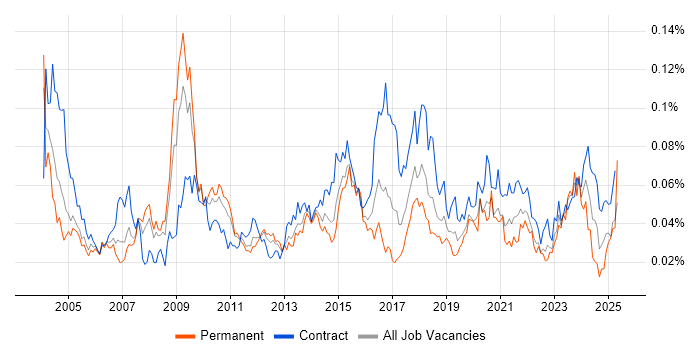Integration Specialist
England > London
The median Integration Specialist salary in London is £29,000 per year, according to job vacancies posted during the 6 months leading to 21 May 2025.
The table below provides salary benchmarking and summary statistics, comparing them to the same period in the previous two years.
| 6 months to 21 May 2025 |
Same period 2024 | Same period 2023 | |
|---|---|---|---|
| Rank | 383 | 495 | 611 |
| Rank change year-on-year | +112 | +116 | +279 |
| Permanent jobs requiring an Integration Specialist | 3 | 15 | 7 |
| As % of all permanent jobs advertised in London | 0.023% | 0.063% | 0.021% |
| As % of the Job Titles category | 0.026% | 0.067% | 0.022% |
| Number of salaries quoted | 1 | 5 | 5 |
| 10th Percentile | - | £67,500 | £42,966 |
| 25th Percentile | £28,500 | £82,500 | £46,000 |
| Median annual salary (50th Percentile) | £29,000 | £85,000 | £47,500 |
| Median % change year-on-year | -65.88% | +78.95% | -26.92% |
| 75th Percentile | £29,500 | £95,000 | £48,750 |
| 90th Percentile | - | £101,000 | £54,000 |
| England median annual salary | £75,000 | £47,500 | £46,625 |
| % change year-on-year | +57.89% | +1.88% | -6.75% |
All Permanent IT Job Vacancies
London
For comparison with the information above, the following table provides summary statistics for all permanent IT job vacancies in London. Most job vacancies include a discernible job title that can be normalized. As such, the figures in the second row provide an indication of the number of permanent jobs in our overall sample.
| Permanent vacancies in London with a recognized job title | 11,673 | 22,288 | 32,092 |
| % of permanent jobs with a recognized job title | 90.27% | 94.23% | 95.15% |
| Number of salaries quoted | 7,198 | 16,617 | 23,725 |
| 10th Percentile | £41,250 | £37,500 | £42,444 |
| 25th Percentile | £55,000 | £51,250 | £55,000 |
| Median annual salary (50th Percentile) | £75,000 | £70,000 | £72,500 |
| Median % change year-on-year | +7.14% | -3.45% | +3.57% |
| 75th Percentile | £100,000 | £93,750 | £95,000 |
| 90th Percentile | £122,500 | £115,000 | £115,000 |
| England median annual salary | £56,000 | £53,000 | £60,800 |
| % change year-on-year | +5.66% | -12.83% | +1.33% |
Integration Specialist
Job Vacancy Trend in London
Job postings that featured Integration Specialist in the job title as a proportion of all IT jobs advertised in London.

Integration Specialist
Salary Trend in London
3-month moving average salary quoted in jobs citing Integration Specialist in London.
Integration Specialist
Job Locations in London
The table below looks at the demand and provides a guide to the median salaries quoted in IT jobs citing Integration Specialist within the London region over the 6 months to 21 May 2025. The 'Rank Change' column provides an indication of the change in demand within each location based on the same 6 month period last year.
| Location | Rank Change on Same Period Last Year |
Matching Permanent IT Job Ads |
Median Salary Past 6 Months |
Median Salary % Change on Same Period Last Year |
Live Jobs |
|---|---|---|---|---|---|
| Central London | +23 | 1 | £29,000 | - | 1 |
| Integration Specialist England |
|||||
Integration Specialist Skill Set
Top 30 Co-occurring Skills and Capabilities in London
For the 6 months to 21 May 2025, Integration Specialist job roles required the following skills and capabilities in order of popularity. The figures indicate the absolute number co-occurrences and as a proportion of all permanent job ads across the London region featuring Integration Specialist in the job title.
|
|
Integration Specialist Skill Set
Co-occurring Skills and Capabilities in London by Category
The follow tables expand on the table above by listing co-occurrences grouped by category. The same employment type, locality and period is covered with up to 20 co-occurrences shown in each of the following categories:
